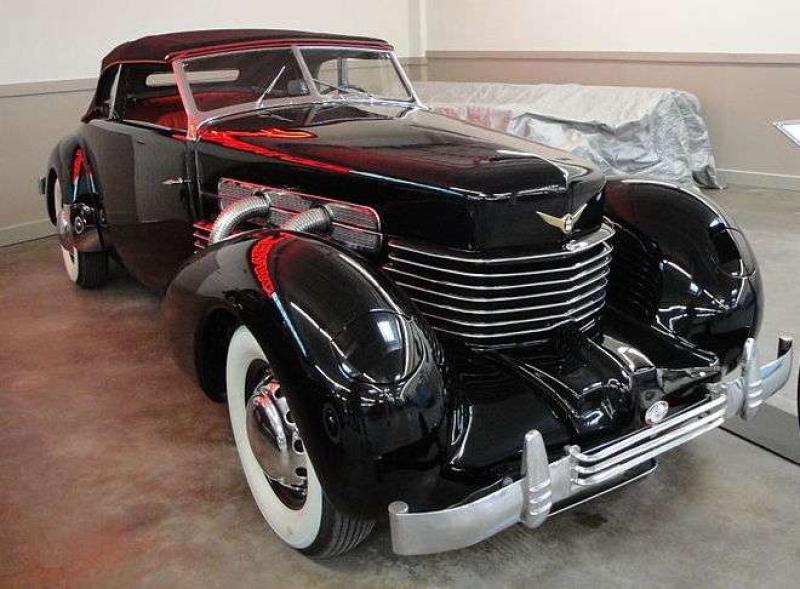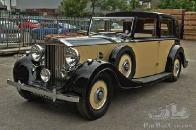Cord
By: Gordon Buehrig (Historic Vehicles)

CORD

Errett Lobban Cord ran some 150 transport-related companies in the USA and in 1924 he was approached to help out at the struggling Auburn Automobile Company. However, Cord countered with a leveraged buyout proposal that was accepted. Cord sold off the old stock and then began the glory days for Auburn and a new brand, Cord.

1929 Cord L-29 Phaeton - Chris J Moffett
E L Cord also acquired the Limousine Body Company, along with Duesenberg and Lycoming.
The Cord brand was designed to slot between Auburn and Duesenberg cars and was noted for its innovative technology and streamlined designs. Cord innovations included front-wheel drive with constant-velocity joints on the L-29 and concealed headlamps on the 810 and 812.

Cord L-29 Cabriolet - Jim-Evans
The Cord L-29 was the first American front-wheel drive car to be offered to the public, beating Ruxton by several months, in 1929. The brainchild of former Miller engineer Cornelius Van Ranst, its drive system borrowed from the Indianapolis 500-dominating racers, using the same proved de Dion layout and inboard brakes.
The front end was a brilliant design that squeezed a gearbox, differential, inboard drum brakes and drive half-shafts ahead of a shortened chassis, without the common projecting 'dumb irons'.

L-29 Cord - ACD Museum
Suspension was handled by four forward facing, quarter-elliptic leaf springs that were shackled to a de Dion tube that run across the front of the vehicle. It was, in effect, a rear-wheel drive de Dion arrangement turned around and mounted at the front of the car. Brilliant!
The lack of a propellor shaft and driving rear axle meant that the L-29 had a lower chassis than its rear-wheel-drive competitors and that fame height allowed low, rakish body designs that others couldn't match.

Cord L-29 - R M Auctions
The L-29 was powered by Lycoming's 4934 cc (301 cu in), 125 hp (93 kW), straight-eight 120, with front-mounted flywheel and three-speed transmission. With typical bodywork the L-29 tipped scales at more than two tons, so performance was modest, with a top speed of only 80mph, but handling was reportedly, superb.
Pricing was on a par with Cadillac, Marmon, Lincoln, Packard, Franklin and Stutz, at around US$45,000 of today's money.
The L-29 was produced until 1932, with around 4400 sold, when the Great Depression hit luxury vehicles sales very hard. Even price reductions failed to improve the sales position and the L-29 bit the dust in 1932.

1937 Cord 812 - Brian-Snelson
Cord rebirth came three years later with the 810 model - and later 812 -that are the best-known of the company's products. They feature unique styling by Gordon Buehrig - arguably the most beautiful American cars ever made - and caused an absolute sensation at the New York Auto Show in 1936.

The 810 had streamlined bodywork and was so low to the ground that running boards were unnecessary. Standard features included 'disappearing' headlights that were operated by dashboard hand cranks; full instrumentation and a radio. Hidden door and boot hinges preserved its sleek exterior.
Early production models had coolant and oil fillers under a flap in the front cowl: water overflow spilt on the ground, but the engine oil level could be checked by pressing a switch that converted the fuel tank level gauge to engine oil level.
The 810 had the same front-wheel drive and independent front suspension as the L-29, but the engine was a shorter, Lycoming V8 that displaced 4739 cc (289 cu in) and produced the same 125 horsepower (93kW) as the L-29.

1936 Cord 812 Phaeton - Greg Gjerdingen
The 810 had a four-speed, electrically-selected semi-automatic transmission that proved troublesome and delayed deliveries until well into 1936. Only 1174 Cord 810s were delivered in the first model year, so they were re-numbered as 812s and sold in 1937.
However, there was supercharging option on the 812, using a Cummins-Schwitzer blower that boosted power to a much more acceptable 170hp. Supercharged 812s had four distinctive, chromed, external exhaust pipes.
The end came in late 1937, when Cord production ceased.
The Cord empire, amid allegations of financial fraud, was sold to the Aviation Corporation, and E L Cord moved to Nevada, where he found real estate and other enterprises more profitable than luxury car manufacture.
No politics, no religion, no instagrams, and commentary must be civil. The ToS and the CoC will be enforced, and anything that the administrator deems to be offensive will be deleted. YouTubes, videos and images that the administrator is unable to open must be described and explained or they will be deleted.






I was always fascinated by the appearance of the front end of the Cord.
But unfortunately, many of the best things in life disappear too soon.
Isn't the Tucker an example of that?
Incredible design!
That's how I felt as well.